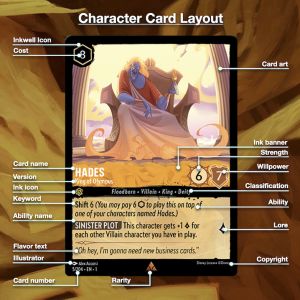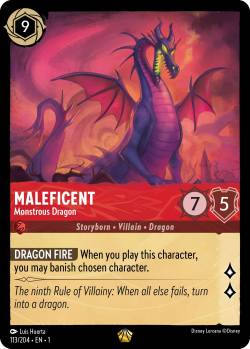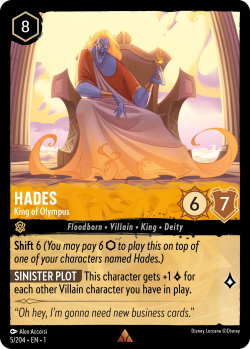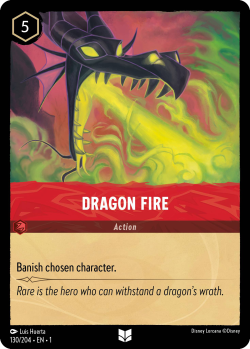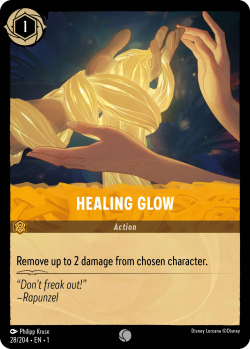
Cost
Jump to navigation
Jump to search
| Cost | ||||||||||||
|---|---|---|---|---|---|---|---|---|---|---|---|---|
| ||||||||||||
Cost is the part of a card that shows the amount of Ink ![]() need to play that card. It is depicted as a number between 1 and 10, contained within a hexagon shape (the Cost icon), located in the top left corner of every card. This icon is also used in some card abilities, as a cost that must be paid to use the ability. When playing a card or using an ability with an Ink cost, the player must Exert that amount of Ink in their Inkwell.
need to play that card. It is depicted as a number between 1 and 10, contained within a hexagon shape (the Cost icon), located in the top left corner of every card. This icon is also used in some card abilities, as a cost that must be paid to use the ability. When playing a card or using an ability with an Ink cost, the player must Exert that amount of Ink in their Inkwell.
Some abilities can reduce the amount of Ink needed to play a card (Lantern). This does not change the Cost of the card, for the purposes of abilities that reference a card's cost (Gantu - Galactic Federation Captain). The amount of Ink to be paid cannot go below 0.
Some abilities will refer to playing a card for "free" (Just in Time). This means that no ink needs to be paid to play that card. When an ability refers to using an ability for free (Maui's Fish Hook), it only refers to the Ink cost.
Inkwell icon
The Inkwell icon is an addition to the normal hexagon icon, consisting of swirling ink. Once per turn, a player may place a card with the Inkwell icon into their Inkwell. The card must be revealed to opponents before being placed in the Inkwell, to show that it has the Inkwell icon. Ink added to the Inkwell this way enters the Inkwell ready, and can be used that turn to pay for costs. These cards are often referred to as "Inkable".
Cards without the Inkwell icon cannot be added to the Inkwell in this way. Cards that include an ability to add a card to the Inkwell facedown (Mickey Mouse - Detective) do not require that card to have the Inkwell symbol. Cards that allow the player to add an additional card to the Inkwell (Belle - Strange but Special) follow the normal rules of adding cards to the Inkwell. These cards are often referred to as "Uninkable".
When constructing a deck, players are encouraged to consider the ratio of Inkable to Uninkable cards they use. Including too many Uninkable cards may make it difficult for the player to add any Ink to their Inkwell, which in turn makes it difficult to pay for cards. It is generally recommended to keep the ratio of Uninkable cards to total cards below 25%.
Inkable vs. Non inkable
| All Cards | ||||||||
|---|---|---|---|---|---|---|---|---|
| Cards | 260 | 236 | 240 | 227 | 246 | 220 | 1429 | |
| Percentage | 78.31% | 73.07% | 75.47% | 72.99% | 81.73% | 75.6% | 76.17% | |
| Cards | 72 | 87 | 78 | 84 | 55 | 71 | 447 | |
| Percentage | 21.69% | 26.93% | 24.53% | 27.01% | 18.27% | 24.4% | 23.83% |
Design Philosophy
Some cards do not have the Inkwell icon as a way to lower the utility of some of the more powerful cards.
Disney Lorcana co-designer Ryan Miller stated that “It allows a really interesting balancing tweak that we can do, because by taking the ink off of a card and saying this card doesn’t provide you ink, it really changes your valuation when you’re building your deck. It’s really got to justify itself now because I can’t use it as ink. [...] I believe that the experienced trading card gamers are really going to find that very interesting.”
The Ink system makes resource generation a choice rather than luck, and adds complexity to the game as any card that is added to the Inkwell can no longer be used for the rest of the game.
Ryan Miller adds “[I’ve] got to decide which of these cards is the least useful to me this game, and I’m going to decide that by looking at the [other cards on the] table. That’s the best kind of decision to make, because I feel — as a player — I’m using my skill now. I can see from what they’re playing, they’re doing this strategy. [...] So I’m gonna go ahead and ink that [high-value card]. I feel good about that decision: I feel like I’ve used my skill.”
Another key advantage of the ink design that Miller enjoys is that it expands what he calls variance. By giving every card in that 60-card deck multiple functions — being used as ink, being used to gather lore, or being used for some other unique action — further compounds the amount of variance in every deck.
“The reason I want to add variance is that variance gives hope,” Miller said. Without that added variance, players that start losing the race to 20 lore could have a higher chance to continue losing the race over time. Higher variance gives players more things to do, more cards to play in the attempt to narrow that gap. “Without variance, there can be no hope.”[1]
A Character card with the Inkwell cost icon
Maleficent - Monstrous DragonA character card with the plain cost icon
Hades - King of OlympusAn Action card with the plain cost icon
Dragon FireAn Action card with the inkwell cost icon
Healing Glow
References
| Card Layout | ||
|---|---|---|
| Card | Card Front (Regular • Foil) • Card Back (Regular • Gold) • Lore Card | |
| Card Types | Action • Character • Item • Location | |
| Ink Colors | ||
| Card Properties | All Card Types | Card name • Cost • Inkwell |
| Characters | Version • Classification • Strength • Willpower • Lore Value | |
| Locations | Version • Move Cost • Willpower • Lore Value | |
| Text Box | Ability (Keyword) • Flavor text (Rules of Villainy) | |
| Rarity | Common • Uncommon • Rare • Super Rare • Legendary • Enchanted • Epic • Iconic • Special Rarities (Promo • Mark • Disney 100) | |
| Other Texts | Illustrator • Collector Number • Copyright | |
